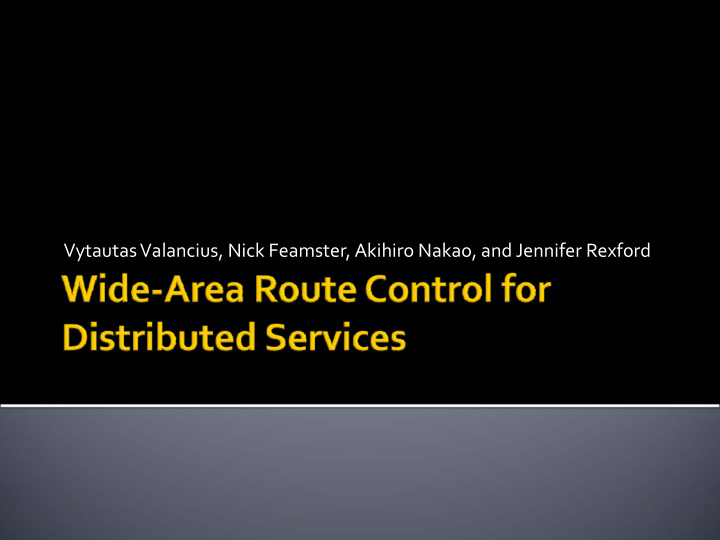



Vytautas Valancius, Nick Feamster, Akihiro Nakao, and Jennifer Rexford
� Cloud computing is on the rise � Provides computing resources and storage in cloud data centers � Hosting on the steroids for Internet services 2
ISP1 � Hosted Interactive services have Service Data Center Internet different Router requirements � Too slow for ISP2 interactive Bulk transfer service, or � Too costly for Cloud Data bulk transfer! Center Routing updates Packets 3
� Multiple upstream ISPs � Amazon EC2 has at least 58 routing peers in Virginia data center � Data center router picks one route to a destination for all hosted services � Packets from all hosted applications use the same path 4
� Obtain connectivity to upstream ISPs � Physical connectivity � Contracts and routing sessions � Obtain the Internet numbered resources from authorities � Expensive and time ‐ consuming! 5
Interactive Service ISP1 Virtual Router A Internet Transit Portal Virtual ISP2 Router B Full Internet route control to hosted Routes cloud services! Bulk transfer Packets Cloud Data Center 6
� Motivation and Overview � Connecting to the Transit Portal � Advanced Transit Portal Applications � Scaling the Transit Portal � Future Work & Summary 7
� Separate Internet router for each service � Virtual or physical routers � Links between service router and TP � Each link emulates connection to upstream ISP � Routing sessions to upstream ISPs � TP exposes standard BGP route control interface 8
� Cloud client with two ISP 2 ISP 1 upstream ISPs � ISP 1 is preferred Traffic � ISP 1 exhibits excessive Transit Portal jitter BGP � Cloud client reroutes Sessions Virtual BGP through ISP 2 Router Interactive Cloud Service 9
� Server with custom routing software � 4GB RAM, 2x2.66GHz Xeon cores � Three active sites with upstream ISPs � Atlanta, Madison, and Princeton � A number of active experiments � BGP poisoning (University of Washington) � IP Anycast (Princeton University) � Advanced Networking class (Georgia Tech) 10
� Internet services require fast name resolution � IP anycast for name resolution � DNS servers with the same IP address � IP address announced to ISPs in multiple locations � Internet routing converges to the closest server � Available only to large organizations 11
� TP allows hosted applications use IP anycast Asia North America ISP1 ISP2 ISP3 ISP4 Transit Portal Transit Portal Anycast Routes Name Service Name Service 12
� Internet services in geographically diverse data centers � Operators migrate Internet user’s connections � Two conventional methods: � DNS name re ‐ mapping ▪ Slow � Virtual machine migration with local re ‐ routing ▪ Requires globally routed network 13
Asia North America Internet ISP1 ISP2 ISP3 ISP4 Transit Portal Transit Portal Tunneled Sessions Active Game Service 14
� Scale to dozens of sessions to ISPs and hundreds of sessions to hosted services � At the same time: � Present each client with sessions that have an appearance of direct connectivity to an ISP � Prevented clients from abusing Internet routing protocols 15
� Conventional BGP router: ISP2 ISP1 � Receives routing updates from peers � Propagates routing update BGP Router about one path only � Selects one path to forward packets � Scalable but not Client BGP Client BGP transparent or flexible Router Router Updates Packets 16
� Store and propagate all ISP1 ISP2 BGP routes from ISPs � Separate routing tables Routing Process � Reduce memory Routing Routing Table 1 Table 2 consumption � Single routing process ‐ shared data structures Virtual Virtual � Reduce memory use from Router Router 90MB/ISP to 60MB/ISP Bulk Transfer Interactive Service 17
� Hundreds of routing ISP1 ISP2 sessions to clients � High CPU load Routing Process Routing Routing Table 1 Table 2 � Schedule and send routing updates in bundles � Reduces CPU from 18% to 6% for Virtual Virtual 500 client sessions Router Router Bulk Transfer Interactive Service 18
� Connecting clients ISP1 ISP2 � Tunneling and VLANs � Curbing memory usage Forwarding Forwardng Forwarding Table � Separate virtual routing Table 1 Table 2 tables with default to upstream Virtual BGP Virtual BGP Router Router � 50MB/ISP ‐ > ~0.1MB/ISP memory use in forwarding table Bulk Transfer Interactive Service 19
� Future work: � More deployment sites � Making TP accessible for network research test ‐ beds (e.g., GENI, CoreLab) � Faster forwarding (NetFPGA, OpenFlow) � Lightweight interface to route control 20
� Limited routing control for hosted services � Transit Portal gives wide ‐ area route control � Advanced applications with many TPs � Open source implementation � Scales to hundreds of client sessions � The deployment is real � Can be used today for research and education � More information http://valas.gtnoise.net/tp Questions? 21
Recommend
More recommend